|
|
Labuan's close proximity to Negara Brunei Darussalam has had a major influence on the island's socio-economic and cultural evolution. More than 60% of the 60,000 local are descendents of the Brunei Malays.
As such, Bahasa Brunei is the major lingua franca on the island.
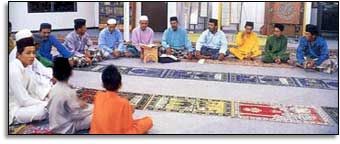
The Brunei Malays
The Brunei Malays are found along the west coast of Sabah as far as Papar and in Limbang in Sarawak and the 5th District area of Brunei. They originated from the Brunei Sultanate, which had survived for five centuries and at one time included present day Sarawak and some parts of Sabah. As Brunei lost territory during the 19th century, the cultivable area shrank and both the Malays and Kedayans, whose homeland was Brunei, migrated to neighbouring areas, including Labuan which was virtually uninhabited when the British took over. The well-known water villages of Patau-Patau and Kampung Bebuloh were set up by the Brunei Malays, carrying on their traditional lifestyle of living in stilt houses over the sea. These villages consist of large communities with shops, surau and other facilities. They have also settled on land, especially in the Kampung Rancha-Rancha, Lubuk Temiang, Gersik, Tanjung Aru and Pantai areas. Their dialect differs somewhat from the Peninsula Malay dialect. Some of their customs too, are slightly different.
Traditionally these people were fishermen, sailors and traders. Today they fish using modern boats and methods, and many are employed in the civil service and service industry.
------------------------------------------------------------------------------------------------------------
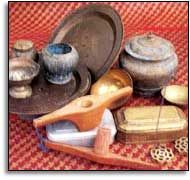
Traditions Or Adat-Adat
The Brunei Malays are found along the west coast of Sabah as far as Papar and in Limbang in Sarawak and the 5th District area of Brunei. They originated from the Brunei Sultanate, which had survived for five centuries and at one time included present day Sarawak and some parts of Sabah. As Brunei lost territory during the 19th century, the cultivable area shrank and both the Malays and Kedayans, whose homeland was Brunei, migrated to neighbouring areas, including Labuan which was virtually uninhabited when the British took over. The well-known water villages of Patau-Patau and Kampung Bebuloh were set up by the Brunei Malays, carrying on their traditional lifestyle of living in stilt houses over the sea. These villages consist of large communities with shops, surau and other facilities. They have also settled on land, especially in the Kampung Rancha-Rancha, Lubuk Temiang, Gersik, Tanjung Aru and Pantai areas. Their dialect differs somewhat from the Peninsula Malay dialect. Some of their customs too, are slightly different.
------------------------------------------------------------------------------------------------------------
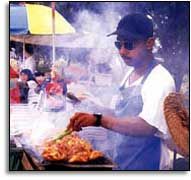
Food
The Brunei Malays have their favourite ways of preparing certain food. Breakfast can be savoury - sticky rice cubes or fried rice - sweet with local cakes like pinyaram, katilapam, calak, tapai and kuripit. The midday and late evening meals have more dishes or lauk-pauk served with rice.
Sometimes fish is prepared by boiling, or by grilling. It can also be made into 'ampap' which is seasoning the fish with salt, chilli, 'asam' (for sourness) and water, then drying it so that the flavouring is absorbed into the fish.
Favoured vegetables are pegaga - small-leafed plant which also has medicinal purposes, lamiding which is wild tender fern shoots, rebung (bamboo shoots), kulat (fungus) and other local greens like cangkuk manis, kangkung and bayam. By mixing chopped pegaga leaves into the rice, the Brunei Malays believe it can help them live longer and healthier lives
------------------------------------------------------------------------------------------------------------
Gift-Giving & Social Behaviour
As in most other societies, its not the gift but the thought that counts. In the past, the presentation of gifts was done formally - elaborately wrapped and presented on a brass tray. This is still practiced at engagements and weddings.
Good manners and respect, especially shown to the elders by the younger people, is very important. An appropriate form of address for an older man is 'tangah' and 'babu' for a woman.
------------------------------------------------------------------------------------------------------------
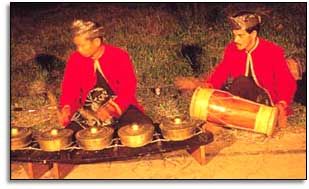
Music
The Brunei Malays have many musical instruments, some of which are similar to other ethnic groups in Sabah. They play the kulintangan which is a set of small gongs on a wooden frame, agong (bigger gongs), tawak-tawak (also gongs), gambus (lute with six strings), gendang (drum) and the duck gongs which are small thick discs that sound different from the other gongs mentioned.
These instruments are played by accomplished musicians and can be special occasions, like a wedding. Sometimes the guests join in singing the dondang songs, and yadan.
This involves starting with a standard phrase to which impromptu lyrics are added on and sung in teasing, light-hearted manner.
------------------------------------------------------------------------------------------------------------

The Wedding Ceremony
A wedding is considered an important event full of adat-adat. In the past, most marriages were arranged but these days this is no longer practiced. In the earlier days, the couple would most likely to be betrothed while still children, and contact with each other was kept to a minimum until the actual marriage ceremony.
Today when a young man fancies a certain girl, he expresses it by indicating to his parents a longing for a house ladder. A 'match maker' is engaged to do some discreet enquires. If nothing happens, a group including the parents will go to the girl's house and recite verses about thunder, ladders and thatch which are all defective - and a request is made - can the flower be plucked from the vase? If the reply is that she will fix all these things it means the answer is a positive one, and an engagement is in the works. If these things have already been fixed or are sturdy stuff, that is the end of the enquiry.
Once everything have been accepted, the dowry or mas kahwin or berian for the bride is discussed. This can be in cash or gold and the amount depends on a number of factors. Once settled, it is ceremonially conveyed to the bride's house and effectively puts a seal on the negotiations. It also helps towards the wedding expenses.
Shortly before the wedding day, a buffalo is slaughtered for the feast. The marriage is solemnised and registered just before the wedding ceremony and the Imam will bless the couple.
Early on the morning of the big day or sometimes the night before, the 'powdering ritual' is carried out in the bride's house. It is a form of beautification and done by a group of older women. The bride is wiped with rice flour to whiten and brighten her face. Saffron rice, scented water, sirih, betel nut and a variety of flours are also used and are placed inside a special container or bintang. The fingers and toes of the bridal couple are then hennaed.
At midday the baalis ceremony is held, followed by gual-gualan. Somber music is played by a Hadrah group. The 'bathing' ceremony is then conducted. Both the bride and groom are assisted by special groups separately. They then return to their respective houses. The akad nikah ceremony is next.
The groom, all dressed up in wedding finery and holding a handkerchief departs with his party to the bride's house where once again permission is seeked for him to be her husband. Before leaving his house, the groom smokes a ceremonial cigarette, urged on by the villagers. Then accompanied by the hadrah group with a candle and colourful flowers called bunga puan, he is 'towed' by the handkerchief. At the foot of the stairs at the bride's house, he is turned around three times and is sprinkled with saffron rice on the way up. Upstairs, the bride is behind several layers of curtains on the bridal dais. The groom pays for the curtains to be removed and the face of the bride is also revealed from behind a veil. The groom touches the forehead of the bride three times. This done, the couples sits on the dais. This is known as the bersanding ceremony.
At night the persandingan is held, where the bride meets the groom's relatives and friends. The couple then retire to different rooms. They are not supposed to sleep until morning as the Brunei Malays have a belief that the one who falls asleep first, also dies first. To keep them awake, dancing and singing is carried on all night long. Everyone sleeps in the next morning.
The bridal couple are not allowed to leave the house for seven days. Another bathing ritual on the third day allows the groom to 'kidnap' the bride at will. On the fifth day, the bride accompanied by relatives and small children, meet with her in-laws. She has to behave shyly and hide her face. They then present her with items of gold jewellery as well as kitchen utensils. Thus ends the elaborate Brunei Malay wedding ceremony.
------------------------------------------------------------------------------------------------------------
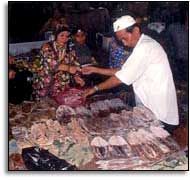
The Kedayan
The Kedayan people make up about half of Labuan's population, and like the Brunei Malays have moved into adjacent areas in Sarawak and Sabah. Their origins are somewhat mysterious, with some claiming to have Javanese origins. But some researchers think they may have Kalimantanese roots. Hose, in his research in 1912 classified them under his early Kalimantan group, while Leach in 1950 thought they might have been an early cultural stratum of a Murut-Kelabit type, who became Islamised and eventually drawn into Malay cultural influence, especially with the setting up of the Brunei Sultanate.
In Labuan the Kedayan make up just over half of its Muslim population. They speak a Malayic language which is similar to Malay, but they have their own distinctive culture and like to preserve their own identity.
In the past, the Kedayan people have shown a streak of rebellion and had rebelled twice within the last 114 years. In 1884, together with the Bisayan and Limbang Muruts, they took part in a rebellion in the Limbang area against the Brunei temenggongs and rajas. They rebelled again a few years later and questions were asked whether this sparked off an influx of Kedayan people into Labuan.
The early Kedayan were mainly padi farmers. Today, as there are hardly any padi grown in Labuan, the ones that are still farming tend to grow fruits and vegetables instead. An interesting note is the Kedayan's knowledge of use of medicinal plants. They grow plants which are used to treat a wide range of ailments, and sometimes they mix the plants to make tonics. They also have plants for antidotes.
------------------------------------------------------------------------------------------------------------
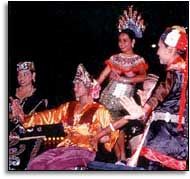
Lifestyle
The Kedayan are not coastal people, and in Labuan they tend to settle more inland. The houses in the village follow a cluster pattern, built quite closely together with gardens radiating outwards.
They tend to be a rather closed community, with little contact with outsiders. This was especially so in the past. Inter-marriage among relatives is encouraged and parents prefer a relative for economic and social reasons. They trace their kinship on both sides of the family, and relatives are all equal, be they from the father's or mother's side. In addressing others, the Kedayan are more equalitarian, and use 'Kau' to address everybody. The women work as hard as the men and as such, are entitled to own land.
They do not follow Islamic inheritance laws. If the father dies, his property would go to the wife, as administrator. She cannot sell the land without the permission of their children. When she dies, the property will be divided up equally among the children, regardless of sex or age. If anyone has excess padi land, he would allow friends or relatives to use it for free. Sometimes the excess land will be given to them if they are landless. As a result, land redistribution among the Kedayan communities is quite easy.
The wedding ceremony of the Kedayan is similar to the Brunei Malays, but one difference is that when the bride is about to get married, she is seated among candles and other decorations and the older folk will go up to her, one at a time, and mark her forehead with powdered spices. This is similar to the Bajau practice. |
|
|
|
|
|
|
|
|
|
| |
Category: Negeri & Negara
|